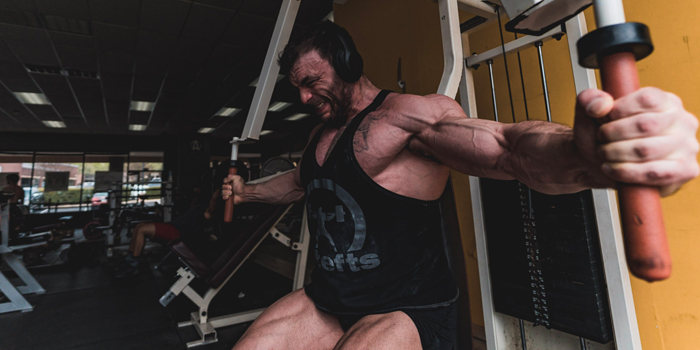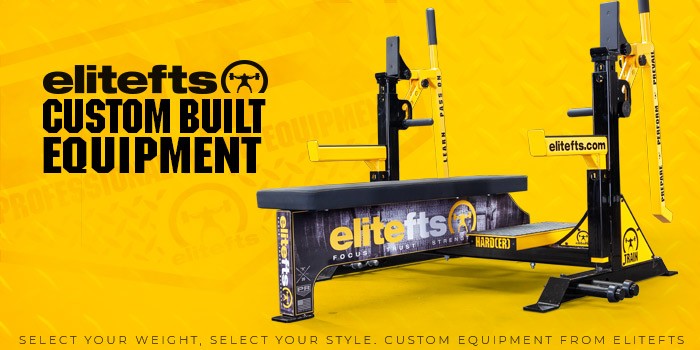
In case you’re not familiar with this article series, over the past year or so, I’ve been writing about how I apply bodybuilding training methods to help improve my powerlifting performance. Recently, I’ve started trying the opposite approach, as well: using powerlifting to improve my physique. And it’s working, really well. If you find this article helpful, be sure to check out others in the series!
When it comes to powerlifting, the chest often gets overlooked as the red-headed stepchild of the upper body. The bench press is king, yeah, but because of the popularity of equipped lifters, I think many people focus too much on the triceps, shoulders, and lats, and not enough on what really should be a main mover in the bench for raw lifters: the pecs.
RELATED: Powerlifting for the Bodybuilder — The Triceps
In bodybuilding, though, pecs are second perhaps only to biceps. Just look at the most iconic bodybuilder of all time.
Yeah, if you wanna be a bodybuilder, you have to lift heavy-ass weights and build a big-ass chest. And if you’re a raw powerlifter, you might well benefit from the same. Unfortunately, that’s easier said than done! So here are some ideas to help you get started.
Using the Chest in the Bench — And in Other Movements
Pecs are not just for strength off your chest in the bench. Besides helping to stabilize the bar during the descent, squeezing the pecs can help to lock out a heavy bench. Of course, the triceps are still primary movers here as well, but if you want to use as much weight as possible, you have to recruit as much muscle as possible, too.
But a lot of lifters — myself included — struggle with really involving the pecs to their full extent in any movement, because the shoulders, triceps, and lats tend to take over (like I mentioned above). So, if you’re struggling, it’s important to try some different cues. Hell, even if you’re not a powerlifter, you might struggle to use your pecs in some movements. Don’t underestimate the importance of a strong mind-muscle connection regardless of what you’re training for.
Cues for Using the Pecs
Before I get into the cues themselves, I want to reiterate my caveat about any cue: it might work for some people, but that doesn’t mean it’ll work for you. It’s important to try a wide variety of cues until you find the one that “clicks” with your mind and your body.
So don’t get too hung up on this section! There’s a lot to be said for simply lifting more heavy s&$!. If you’re really struggling, it is possible that you just don’t have the pec size and strength necessary to really “feel” them working in compound movements, and you’re better off cranking out your bench anyway (with good technique) until you’ve got that base built.
That said, if you’re not a raw beginner, you’re probably not in that category. Chances are, you just need a little push in the right direction — the right cue, the right movement, the right position, whatever — to get that click. And once you do, you’ll be able to use your pecs in nearly any upper-body movement.
With that out of the way, here are some of my favorite cues for recruiting the pecs:
- Squeeze the biceps. This sounds like a weird one, but remember: everything’s connected. Trying to squeeze your biceps together forces you to bring your arms in (unless the weight keeps them out) and helps to get that maximal contraction at the end of your range of motion on both pressing movements and flyes.
- Keep the chest up. Personally, I focus on the serratus rather than the chest, as it helps me keep my entire torso stacked properly. What’s important, though, is that you “open up” the pecs (like you would in a front lat spread) to help get that nice, deep stretch on the eccentric and keep your shoulders in a safe position on the concentric.
- Focus on the elbows. Especially on pressing movements, if you’re trying to go heavy, you’re probably going to get a lot of front delt and triceps involvement — which is fine for moving heavy weight, but not great for building big pecs. If you focus on your elbows rather than your hands, and remember that the pecs bring the arm (and therefore elbow) across the body, you’ll have an easier time avoiding that.
One more tip: go slow. Again, if you’re in the habit of letting other muscle groups take over if you rush things, you’re just going to fall back into that pattern. Slow it down and do it right.
My Favorite Chest Accessory
When I’m looking for chest accessory movements, I’m focused primarily on range of motion. I find that barbell movements and even most dumbbell movements simply don’t allow for enough stretch to really engage the pecs as much as I’d like. Unfortunately, most machines have some pretty difficult levers for me: despite the extended range of motion on, for example, a Hammer Incline Press, my triceps end up limiting a set rather than my pecs.
One exception I’ve found: the suspended pushup. It’s simply a regular wide-grip pushup on rings or a TRX machine, but this slight variation allows for an extreme stretch at the bottom of every rep. Furthermore, suspended pushups require intense focus and effort to stabilize your body and squeeze the pecs at the same time.
Now, obviously, the movement has some limitations. The most obvious is that you need somewhat specialized equipment to perform them, although many gyms today do include that equipment. If you’re a lighter lifter, the movement might not seem challenging enough. Here are some solutions for these drawbacks and more:
- If you don’t have access to rings or a TRX setup, try performing pushups with your hands on a pair of upright dumbbells. While this won’t require the same degree of stabilization, it will enhance the range of motion.
- If the standard motion isn’t challenging enough, you can elevate your feet or even have a partner place a plate on your back before starting a set.
- If you lack the strength or flexibility to perform suspended pushups, start with regular ones, then move to decline pushups (with your feet elevated), then to pushups with feet elevated and hands on dumbbells. This progression should prepare you pretty well.
Finally, be careful. Overstretching the pecs can easily lead to injury!
A Sample Chest Workout for Bodybuilders
This one is an abbreviated sample of week 1 from my new powerbuilding program. If it’s something you want more of, be sure to go check out the full course, but remember: everyone is different. I’m not intending this particular workout as part of a long-term program, but rather a sample for you to build off of!
- Flat Bench Press: Warm up thoroughly, then do 1 set of 10 reps with a weight you could use for 12. Rest 2 minutes, add about 10% to the weight and do a set of max reps. Shoot for at least 8 reps
- Incline DB Bench Press: As you lower the dumbbells, bring your arms out wide to the sides – almost as if you were performing a flye. Then press up normally, touching the bells together at the top, but not locking your elbows. Do 3 sets of 12 reps with a weight you could use for 15. Rest 2 minutes between sets.
- Tri-set:
- Cable Crossover: 20 reps. Squeeze 1 second in the contracted position.
- Dip Shrug: 20 reps, don’t add weight. Use this as a mini-break to help catch your breath, but squeeze hard!
- Suspended Pushup: AMRAP (as many reps as possible). If you can’t do at least 10, use one of the other movements from the progression earlier in this article.
- Dumbbell Pullover: I like this as a finisher. Don’t count sets or reps, just go for a sick pump.
I hope you find this program — and this article series — helpful. What would you like to see featured in it moving forward? Let me know in the comments!











I would like to see a similar article on hamstrings, and maybe tailor it towards someone without access to machines.
thanks!